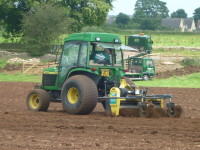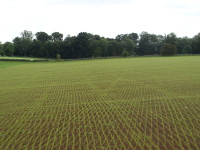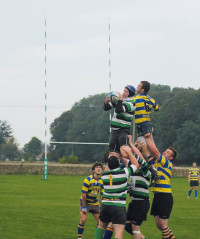Ponies to Penalties for Minchinhampton RFC

Back in 2009, ponies grazed the wispy grass of Crackstone Mill Ground in Minchinhampton, Gloucestershire, just a drystone wall or two away from the Gatcombe Estate of Anne, The Princess Royal. Today, its smooth immaculate turf constitutes four rugby pitches belonging to Minchinhampton Rugby Club. The development will be completed with a purpose built clubhouse overlooking the prime pitches when fundraising is complete.
Until now, Minchinhampton had been a "nomadic" club, without their own ground. Established in 1982, the seniors used some land next to a house which was eventually sold to non-rugby-friendly occupants and the juniors had to use local schools. Their problems were often quite unique: "We frequently played on Minchinhampton Common," said former chairman, Morgwn Atkins. "It would take the first twenty minutes of each session putting up the posts, and the second twenty clearing up cow pats!" For ten years, it was a constant worry finding venues for eight age groups, falling victim to varying standards of pitch care and school sports fixtures, not to mention unco-operative cows! "It was not uncommon for our 'home' game to be in Cheltenham, fourteen miles away," he added.

"It's been an utterly painful and brain-numbing journey from finding and buying the land, getting planning and change of use and dealing with various authorities, but the pitch construction side has been absolutely perfect," said Morgwn.
That construction was carried out by sportsturf contractor, Ecosol Turfcare, who won the tender which had been put out by the RFU and their appointed consultant engineer, PSD Agronomy's John Hacker. "The RFU made the final decision on the contractor appointment, but we were happy as we knew the company had a good reputation, they were locally-based from Malmesbury, and had submitted a very thorough and comprehensive tender."

Once the ponies had been removed, a local farmer mowed the overgrown pasture and made round bale silage to clear it. This enabled the Ecosol team to move in to apply glyphosate on 5 July 2012 and progress, seven days later, by ploughing it, discing and power harrowing. This revealed that the brashy soil was as shallow as 150mm in places, causing plough shares to bounce along the bedrock!
"We knew it required an awful lot of work to transform it from fields to top class pitches," said Tony Dowie, Minchinhampton grounds manager, "but we were confident in the contractors ability to bring it about."

Following an initial grading, manual stone removal took place (some as big as headstones!) which netted over twelve tonnes of beautiful drystone walling material. The whole site was then graded more finely to remove the old hedge line and surface undulations so that the 1st XV and 2nd XV pitches had longitudinal falls of 1:110 and 1:83 respectively with transverse falls of 1:46 and 1:42.
Once completed, the painstakingly slow BLECavator stone burier was then deployed to bury all stone greater than 25mm in size. Nevertheless, it worked well despite the volume of rock, as the material was successfully buried 150mm below the surface.

Despite the wettest summer for many years and all its interruptions to work, barely seven weeks from the start of the operation on 24 August 2012, the entire area was given a 400kg/ha NPK application of 10:15:10 pre-seed fertiliser and then seeded at 40g/m² with Barenbrug Bar 7, a pure ryegrass blend of four cultivars.
Manual stone picking followed this; the surface was firmed with a light roll, then left alone to establish for a month before the first mowing as the grass reached 60mm height. Four further autumn cuts were managed, as well as a winter 4:12:12 feed being given in October 2012.

Finally, almost a year after starting, Ecosol was able to mark out the four pitches and erected 13m aluminium goalposts from Mark Harrod Ltd, hinged because the strict planning consent requires the club to be able to take them down from time to time.

"Ecosol have been pretty brilliant to work with," recalled Morgwn Atkins. "The quality of the work speaks for itself, but also, they have been excellent communicators, keeping us up to speed every step of the way, even sending photos of the work and erecting signs to keep the public informed and the site safe and secure. They have acted over and above the call of duty."
Having the new ground has been excellent for the club's morale. The club's committee were ecstatic when they bought the land, hit a trough and anti-climax whilst struggling to get the various permissions, but then shot back onto a high when everyone saw the construction kicking off. The new ground has raised the club's profile, brought everyone together and made it easy to retain senior players.

Minchinhampton have erected two portable buildings until funds allow the clubhouse work to proceed, but the pitches themselves are now well established and being used by the seniors and a blossoming junior section.
"It's a truly amazing transformation," said Tony Dowie. "The pitches coped brilliantly with such a dry summer. I can personally vouch for the fact that they are great to play on and everyone is saying how good they look."
The club's first league game took place against Cainscross on 28th September, supported by over 200 spectators. A "ribbon-cutting ceremony" and barbecue heralded the next chapter in the progress of Minchinhampton RFC.
